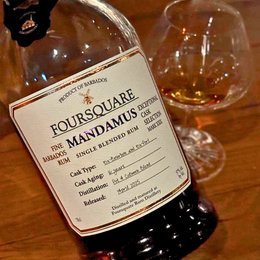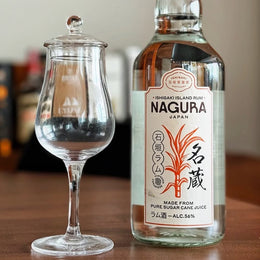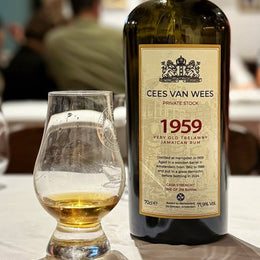(Rarest of Rare Series): The Rest of ‘em: Wray & Nephew 25 Year Old (25 years), Barbancourt 25 Year Old, bottled by Reserve Veronelli in the 1970s (25 years), Bacardi Superior - Early 1900s Bottling (age unknown)

Background: the sequel to this post, with reviews of the rest of the Rarest of the Rare tasting set.
Name: Wray & Nephew 25 Year Old (25 years)
Nose: good depth -- it is hard to believe this is watered down to a paltry 43%; the sweet, creamy and thick musk that is so integral to Samaroli West Indies 1948 can be found here; it is more subtle, though still the core of the aromatic profile; very dense and compact; vanilla essence; sandalwood incense; the musty interior of an old wooden cabinet; vintage woollen coat; toasted malt and barley sugar, evocative of old-style highland malts; sesame, walnut and almond paste; sweet nihonshu; the standard column-still rum character, full of molasses and demerara sugar syrup; a melange of tropical fruits, including jackfruit, mango, pineapple, guava and soursop; some savoury, oily notes lurk beneath; dark soy sauce; honey baked ham; sugarcane smoked fatty pork; the base notes are squarely in the realm of wood and earth; tree bark; dried leaves; old pu-er and rougui teas; wood smoke; baked clay and a general peaty earthy character.

Palate: the same complaint levied at the Samaroli, “not as thick and luscious as the nose suggests” -- this is even quite watery; the perfume-y musk is is more obvious here; in fact, it dominates the palate, providing a solid base for other flavours to accoutre; grape bubblegum; stewed apples; sarsaparilla drink; demerara syrup; deuk deuk tong; creamy sandalwood accompanies floral essential oils, most notably that of lavender; green vines and chinese liquorice; boiled gingko nut; barley water; walnut and peanut skin; unripe mango, yellow papaya and banana; soy by-products the likes of dark soy sauce, stale soy milk, tau huay with gypsum; anise and menthol; the wood from the cask shows up on the back-palate, in the form of ginger candy, spice cake, dark chocolate with high cacao content, and dark roast coffee beans.
Finish: medium-long; a bunch of chinese desserts -- tau huay, almond jelly, beancurd barley with gingko nut, grass jelly; the musty cabinet is back, with an entourage of antique furniture; the creamy tropical note usually found in a Hampden, appears in the aftertaste; thereafter, banana milkshake, salted caramel, milk chocolate, nuts powder, senbei, some clay-like earthiness, as well as hints of plasticine and cling wrap.
Conclusion: I love the thick musk and old musty notes. They are extremely rare in modern rums, yet somehow so dominant here as they are in the Samaroli. A result of OBE? Or of certain production processes that went extinct? I might never find out. Nonetheless, it makes sense to benchmark this against the Samaroli. Although the Samaroli leads on the nose and the finish, this is better on the palate -- better complexity, better structure, if somewhat fragile. Much can be said about personal tastes, and I wish it had been a crazier, funkier ride (considering the provenance), but there is no denying this is a great rum.
Score (assuming a normal distribution with mean 50): 89/100
Name: Barbancourt 25 Year Old, bottled by Reserve Veronelli in the 1970s (25 years)
Nose: heavy and dense, like many rums of yore, though not the most expressive -- then again, the Wray & Nephew 25 is a hard act to follow; also, how is this not a demerara? Burnt caramel; blackstrap molasses; roasted barley malt; gula melaka; charred rice cracker; wok-fried coffee beans with butter; sugar roasted chestnuts; some fatty, oily note -- burnt ends come to mind; liquorice; Chinese liang teh, the bitter kind; grass jelly; rubber tyre; Vaseline; cigarette ash; beneath the heavy and funky veneer are fresher and more appetising aromas; cane syrup; dried, dark fruits and dark-fruity red wine; vanilla; cookie dough; pine tree; mint bubblegum.
Palate: this is where it begins to come apart; weak body; the attack is bitter and astringent and it never lets up from there; burnt plastic and rubber; milk coffee; over-steeped black tea; dark and red fruits like currants and prunes dart in for a cameo appearance on the mid-palate, accompanied by a welcomed array of sweets; vanilla; soy milk; burnt shortbread; the back-palate is bitter, evocative of coffee grounds and ash.
Finish: medium-long, just a little shorter than the Wray & Nephew; the cream comes forth here; creamy coconut confectionery the likes of kueh bangkit; bananas foster and banana split; then sugarcane all the way into and through the aftertaste -- roasted cane paired with freshly squeezed cane juice; this must be the purest expression of cane I have ever experienced in a rum.
Conclusion: not as much over the hill as this Silver Seal Clarendon, but still way overoaked. At least the nose is very good and the finish brings something new to the table. A very uneven experience.
Score (assuming a normal distribution with mean 50): 73/100
Name: Bacardi Superior - Early 1900s Bottling (age unknown)
Nose: the singe of alcohol is immediately felt; the backbone is fruity, crystalline, and dairy -- cream cheese, yoghurt, stale milk -- with a slight toasted character, like a Port Charlotte; the supporting aromas come and go, some more ephemeral than others, though it is difficult to keep track of their flow; therein lies the charm of this rum, a liquid analogue to a Godard film; brown sugar; coconut shavings; egg custard; baby vomit; petrol; camphor; fresh cane juice; maltose candy; grape bubblegum; cereal; honeydew; candied pear; crystallised pineapple; salted caramel; savoury green bean paste.
Palate: disappointingly thin, even after I have adjusted my expectations in view of the previous two rums; subpar alcohol integration; the weak and unstable structure is not as appealing here as it is on the nose; the attack is bitter and imbalanced; melting plastic; wax; cooking gas; petrol; camphor; bergamot oil; some sweetness develops on the mid- and back-palate; cane syrup; lavender ice cream; honeydew and pear; grape soda.
Finish: short; damp wood; shoe polish; more cooking gas and petrol; an aftertaste of potpourri, dried fruits, cling wrap and stubborn industrial bitterness; nope, it does not redeem itself here.
Conclusion: I have not tried the modern Bacardi Superior, but I imagine it to be even meeker than this. That being said, I cannot recommend this in good faith -- as good as the nose is, the palate and finish can barely pass as average. Calibrating scores near the mean is not the easiest thing, but here goes.
Score (assuming a normal distribution with mean 50): 56/100
Image Courtesy of u/zoorado.
![]()
u/zoorado







